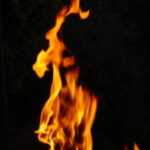With age comes wisdom and, at 43, I’m a lot smarter than I used to be. That’s great. But there are some other things that come to a woman with age that aren’t so great. Like the hormonal changes that come when we enter perimenopause. Hot flashes and night sweats being, in my opinion, the worst of the menopausal symptoms are what this article is about.
I’ve never had a hot flash, but I’ve had enough night sweats to make up for that. Some women suffer all day with hot flashes or power surges as they are sometimes called. Some ladies wake during the night with sweats. Some poor dears suffer all day and night with both!
My night sweats started out mild and worsened with time. At first, I would awaken during the night a bit damp, roll over and go back to sleep. Next, I would have to get up and change my nightgown before going back to sleep. Then, I began to wake up soaking wet. I would have to shower, change my gown and the sheets as well. When this happened four times in the same night, I knew I had to find a solution. I couldn’t sleep anyway, so I used the time to do research. This is what I discovered.
The experts don’t really know what causes hot flashes and night sweats. They generally believe them to be similar phenomena, attributable to the same cause; either too much or too little estrogen. They’re not sure which.
Medical Science Offers Little Help
Other than HRT which is inappropriate for premenopausal women and which some postmenopausal women are afraid to take because of the increased cancer risk. Many physicians tell their patients to just wait it out, that the symptoms will subside naturally once they stop menstruating. Seeing as a woman can enter perimenopause in her late thirties or early forties and not complete menopause until she’s in her middle fifties, that’s a long time to suffer.
Nature to the Rescue
Vitamin E (d-alpha tocopheryl–the natural form) helps the body to metabolize excess estrogen. If you have high blood pressure start with 200 units per day and monitor your pressure as this nutrient can sometimes cause a temporary elevation. If your bp does not rise, increase your dosage gradually (100 units at a time) while continuing to monitor it to 400-800 units a day. If your bp is normal, you may begin with 400 units. I started with 400 units and that’s what I,m still taking. I realized a reduction in symptoms the first week.
Maca, a Peruvian root vegetable, is an effective hormone regulator. It is sold, dried and powdered, either loose in bags or in capsules. The loose powder can be added by the spoonful to food and drinks. I’ve never used this form so I don’t know what it tastes like but it smells like butterscotch. The caps can be taken with or without food. Start with one a day and see how your body responds to that before taking more. Too much can have a stimulant effect and worsen your symptoms. If this happens, just skip a day and reduce your dosage the next day. I find that two 500 mg caps a day keeps me night sweat free for most of the month, but the week before my cycle starts, I have to take three to get the same benefit. Some women have to take six capsules daily to obtain relief. Play with the dosage until you find what works for you.
Maca requires a lengthy drying process to keep it from molding. Some companies take the short cut of irradiating it instead. This destroys its food value. Be sure to purchase your supplements from a company that does not do this. I use Nature’s Herbs brand. It works for me so I’ve never tried any other.
Sage, the cooking herb, is antihydrotic. A tea of two leaves, steeped in hot water and drunk in the early evening will keep you from sweating that night. A stronger decoction will probably leave you with dry eyes and a dry throat. These side effects will subside in a day or so.
If, like me, you live in a place where salvia officinalis does not like to grow, you may substitute another sage. Most of the purple-flowered “ornamental” cultivars are also medicinal. Just be sure that whatever plant you use is a true salvia. There are lots of plants commonly called “sage” that are not members of this family. Never ingest any herb unless you are sure it’s edible. Certain plants can be deadly poisons when eaten. That said, I love sages and have grown many of them over the years. Unfortunately, there is only one which returns reliably for me in the spring. That is salvia leucantha or Mexican bush sage. This is the one I use fresh all summer and dry for winter use. Sometimes, when I’m feeling too lazy to make tea, I’ll just add poultry seasoning (which is mostly sage) to whatever I’m cooking for dinner. Works just as well.
Herbs to Stay Away From
Avoid the febrifuge herbs. These are the ones used to sweat out fevers. Mint, yarrow, catnip and elder are in this class.



